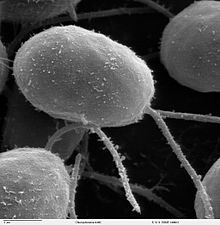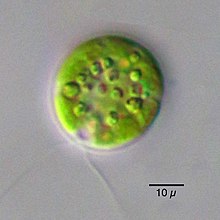क्लैमाइडोमोनास
क्लैमाइडोमोनास (/ˌklæmɪˈdɒmənəsˌ-dəˈmoʊ-/ KLAM-ih-DOM-ə-nəs) हरे शैवाल का एक जीनस है जिसमें लगभग 150 प्रजातियाँ शामिल हैं [2] एककोशिकीय फ्लैगेलेट, स्थिर पानी में और नम मिट्टी पर, मीठे पानी में, समुद्री पानी में और यहां तक कि बर्फ में भी "बर्फ शैवाल" के रूप में पाए जाते हैं।[3] क्लैमाइडोमोनास का उपयोग आण्विक जीव विज्ञान के लिए एक मॉडल जीव के रूप में किया जाता है, विशेष रूप से फ्लैगेलर गतिशीलता और क्लोरोप्लास्ट गतिशीलता, जैवजनन और आनुवंशिकी के अध्ययन के लिए। क्लैमाइडोमोनस की कई खास विशेषताओं में से एक यह है कि इसमें आयन चैनलएस (चैनलरोडोप्सिन) होते हैं जो सीधे प्रकाश द्वारा सक्रिय होते हैं। क्लैमाइडोमोनस के कुछ नियामक प्रणालियाँ जिम्नोस्पर्म में उनके होमोलॉग से अधिक जटिल हैं, विकास संबंधी नियामक के साथ नियामक प्रोटीन बड़ा होता है और इसमें अतिरिक्त डोमेन होता है।[4]
| Automatic taxobox help |
|---|
Thanks for creating an automatic taxobox. We don't know the taxonomy of "Chlamydomonas".
|
| Common parameters |
|
| Helpful links |
| क्लैमाइडोमोनास | |
|---|---|

| |
| एसईएम ध्वजांकित क्लैमाइडोमोनस - शैवाल की प्रजाति की छवि (10,000) | |
| वैज्ञानिक वर्गीकरण | |
| Unrecognized taxon (fix): | Chlamydomonas |
| Species | |
|
See text | |




आणविक फाइलोजेनी अध्ययनों से संकेत मिलता है कि पारंपरिक जीनस क्लैमाइडोमोनस, जैसा कि रूपात्मक डेटा का उपयोग करके परिभाषित किया गया है, वोल्वोकल्स के भीतर पॉलीफाइलेटिक था। कई प्रजातियों को बाद में पुनर्वर्गीकृत किया गया (उदाहरण के लिए, ओगामोक्लैमिस, लोबोक्लैमिस), और कई अन्य "क्लैमाइडोमोनास' एस.एल. वंशावली को अभी भी पुनर्वर्गीकृत किया जाना बाकी है।[5][6][7]
- ↑ Hazen, Tracy E. 1922. The phylogeny of the genus Brachiomonas. Bulletin of the Torrey Botanical Club. 49(4):75-92, with two plates.
- ↑ Smith, G. M. 1955 Cryptogamic Botany Volume 1. Algae and Fungi McGraw-Hill Book Company Inc
- ↑ Hoham, R. W., Bonome, T. A., Martin, C. W. and Leebens-mack, J. H. 2002. A combined 18S rDNA and rbcL phylogenetic analysis of Chloromonas and Chlamydomonas (Chlorophyceae, Volvocales ) emphasizing snow and other cold-temperature habitats. Journal of Phycology, 38: 1051–1064. [1]
- ↑ A Falciatore, L Merendino, F Barneche, M Ceol, R Meskauskiene, K Apel, JD Rochaix (2005). The FLP proteins act as regulators of chlorophyll synthesis in response to light and plastid signals in Chlamydomonas. The red eyespot in Chlamydomonas is sensitive to light and hence determines movement. Genes & Dev, 19:176-187 [2]
- ↑ Juliet Brodie & Jane Lewis (2007). Unravelling the algae: the past, present, and future of algal systematics. CRC Press. p. 140, [3].
- ↑ Wehr, J.D., Sheath, R.G. & Kociolek, J.P. (eds., 2015). Freshwater Algae of North America: Ecology and Classification. Academic Press, USA, p. 275-276, [4].
- ↑ Proschold, T.; Marin, B.; Schlösser, U. G.; Melkonian, M. (2001). "Molecular phylogeny and taxonomic revision of (Chlorophyta). I. Emendation of Chlamydomonas Ehrenberg and Chloromonas Gobi, and Description of Oogamochlamys gen. nov. and Lobochlamys gen. nov". Protist. 152 (4): 265–300. PMID 11822658. डीओआइ:10.1078/1434-4610-00068.